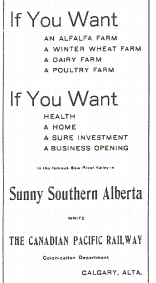
The Canadian Pacific Railway played an important role in the settling of the prairies. The C.P.R. got land from the government of Canada as part of its payment for building the railway lines. As a major landholder the C.P.R. wanted to make money from the sale of land to settlers. In the beginning land sales for the C.P.R. did not proceed as well as expected, so the company established an immigration department to promote the Canadian West. Prior to 1890, the settlers who came out west were mostly English speaking. To get other Europeans to immigrate the C.P.R. promoted community settlement through agents in Europe. Once they arrived on the prairies these groups often settled in one area. There was a campaign in the 1920s that brought 20 000 Mennonite settlers from Russia and the Ukraine. The town of Coaldale was settled as a result of this mass immigration.

P19821029000-GP A train brining in new immigrants to the prairies.
To get more people to settle in the west the C.P.R. established experimental farms in Palliser's Triangle that tested crops and stock against climatic conditions. The results of their research provided excellent information for farmers about strong types of wheat and stock. The C.P.R. also built irrigation systems in southeastern Alberta to encourage settlement. Because the land was irrigated it became more valuable to new settlers, and land sales went up.

Promotional material used by the CPR to attract new settlers to Canada.
While the C.P.R. was doing all this work north of the main line, the Alberta Railway and Irrigation Company was doing the same thing south of the main line. Charles Ora Card was looking for new settlement opportunities for Mormons from Utah. Card and his followers were interested in the Alberta Railway and Irrigation Company’s offers of settlement in southern Alberta. They knew how to irrigate land and the Galt’s wanted to get them to use their skills by irrigating a lot of the land south of Lethbridge. The Mormons also came to Alberta because of the promise of rail service to grain markets. When these lines were built throughout southern Alberta the Alberta Railway and Irrigation Company had seemed to have delivered on their promise.
Without the C.P.R. and other rail companies it would have been very difficult for settlement to succeed on the prairies because of the great distances that settlers had to travel. The C.P.R. offered incentives to potential settlers, including free tickets for those who had purchased land. People who came job seeking, however, were guaranteed nothing.

More promotional material from the C.P.R., and already the area was being called Sunny Southern Alberta!
The railway’s role in immigration became important again after the Second World War, as more immigrants came from war torn Europe. These settlers also traveled by train, but due to a lack of money and less of a need for new settlers, they were no longer guests of the C.P.R., but simply passengers. The trip was comfortable but one woman remembers that the “immigration train” on which she crossed Canada in 1955, would pull over to a side track to give way to the freight trains on the track. The priority of freight on the main lines started a new age of freight transport for the C.P.R. Passengers are still traveling along the rails today, but the main use of the railways is now the transportation of freight.
Previous Page | Exhibit Contents | Home | Navigation Information | Glossary | Curriculum Guide | Next Page
Copyright © 1996 Sir Alexander Galt Museum. All rights reserved.